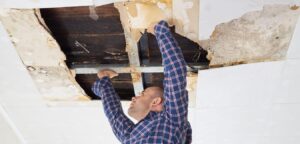For a landlord or business owner, some of the most common issues with property damage come from water. Stained and bulging ceilings, cracks, and peeling paint — the signs of a water emergency are difficult to ignore.
Water damage is ugly and potentially costly. If left unrepaired, the damage can lead to even more dangerous issues with mold. Fortunately, you can fix a water-damaged ceiling in a commercial property. With the right tips and techniques, some property owners choose the DIY approach to tackle the problem. You just need to know how to fix a water-damaged ceiling.
Potential Causes of Commercial Water Damage
Many issues can lead to water damage, making it essential for a commercial property owner to know how to identify water damage. Roof leaks from rain and water build-up, leaking appliances, and burst or broken pipes can all cause problems. The result is discolored drywall that will degrade due to dampness. Damp drywall may bulge, crack, peel, or crumble. Lasting water build-up can even cause mold.
Water damage is ugly and potentially costly. It is a problem that no business owner can afford to ignore.
How to Fix a Water-Damaged Ceiling in a Commercial Property
Fortunately, repairing a water-damaged ceiling is relatively straightforward. Property owners should take a systematic approach to complete the necessary repairs. Finding and stopping the leak, removing damaged drywall, eliminating moisture, patching holes, priming, and painting the ceiling will make the damaged area look like nothing ever happened. Or if you prefer to skip this DIY project, contact a professional such as ServiceMaster Restoration by RSI for prompt, affordable repairs.
Stop the Leak
The first step in fixing a water-damaged ceiling in a commercial property is finding the water source and stopping the leak. If you have access to an attic or roof above the damaged ceiling, check it to find the cause of the damage. When tracking down the cause of the damage, remember that water can spread through drywall, and the source may be quite far away from the damaged ceiling area. If you can’t pinpoint the cause of the water problem, there is no point in making repairs.
Remove Damaged Drywall and Explore the Area
Study the ceiling for signs of sagging or crumbling drywall panels or brown stains. If you see portions of the ceiling where the drywall is bulging, place a bucket underneath the swollen area and puncture it to release the water. Remove the drywall to reveal the cause of the problem. Your goal is to track down the leak and repair it. You may need to call in a plumber to help make repairs.

Dry Out the Area
In this battle to repair the ceiling, your enemy is dampness. You need to know how to clean up water damage. That means you’ll need to dry out the water-damaged area and eliminate any signs of possible mold. You will need to remove any soggy drywall and open up the ceiling section so air can get to it. Put down a tarp to catch dust and debris, grab some safety goggles and a dust mask, and start removing the damaged drywall using the claw end of a hammer or a wrecking bar. Preserve undamaged portions of the ceiling by only cutting out the parts of the drywall that the water harmed.
Electric fans, towels, and time will help dry out the ceiling. You need to eliminate all moisture before you make any repairs. Extracting water and dehumidifying the area is essential. Be on the lookout for possible mold caused by chronic leaks and water problems. Watch out for various types of mold, including “black mold,” which can be toxic in large amounts. If a lot of mold is present — 10 square feet or more in an interior area — call a professional to remove it.
Make Repairs
Now it is time to begin the repair process. Start by using a putty knife to remove any flaking paint or drywall. Sand down any rough areas, smoothing ridges and bumps. Use joint compound to fill and patch small holes.
Larger holes will need new pieces of drywall. When cutting out the drywall, measure two inches wider and longer than the actual hole. You may want to start with a large piece and cut it down gradually. Using adhesive, glue the drywall in place. When it is dry, add a layer of joint compound and smooth it down.
Prime and Paint
Next comes priming and painting. Open the windows for better ventilation and cover the repair area with primer. When that dries, paint the entire ceiling — even the undamaged portions, so the repair will blend in. With proper technique, the repaired area will be undetectable.
Need a Professional?
If your water damage is extensive, you discover mold, or you prefer not to do the repairs yourself, ServiceMaster Restoration by RSI has trained technicians to identify, stop, and clean up water damage, remediate mold, and repair damage.
We understand how important it is for you to have water damage repaired quickly and cost-effectively. Carrying out a DIY repair on a water-damaged ceiling in a commercial property can be difficult and time-consuming. At ServiceMaster Restoration by RSI, we know how to identify and properly fix all commercial water damage. We handle calls 24 hours a day, seven days a week, 365 days a year. Call us at (405) 251-7286.

